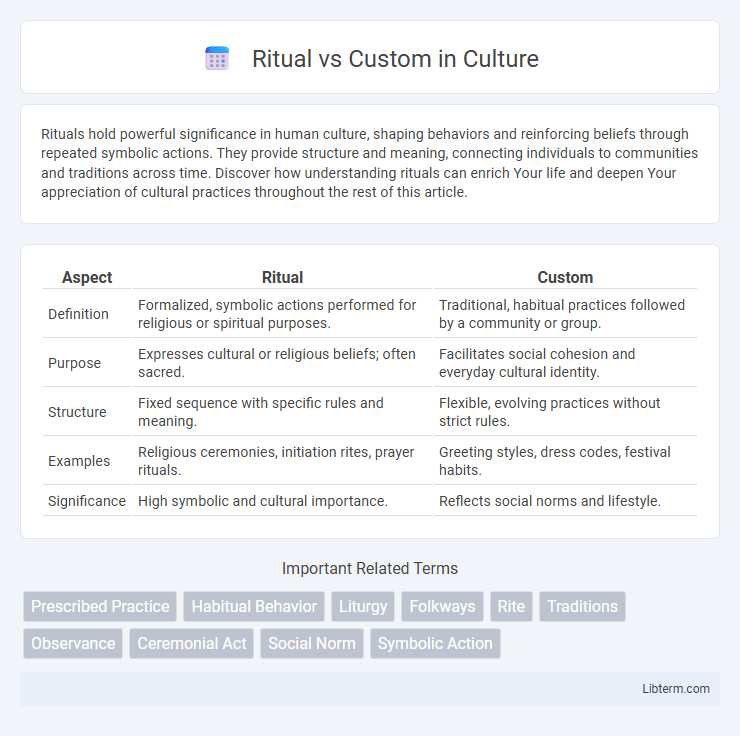Rituals hold powerful significance in human culture, shaping behaviors and reinforcing beliefs through repeated symbolic actions. They provide structure and meaning, connecting individuals to communities and traditions across time. Discover how understanding rituals can enrich Your life and deepen Your appreciation of cultural practices throughout the rest of this article.
Table of Comparison
| Aspect | Ritual | Custom |
|---|---|---|
| Definition | Formalized, symbolic actions performed for religious or spiritual purposes. | Traditional, habitual practices followed by a community or group. |
| Purpose | Expresses cultural or religious beliefs; often sacred. | Facilitates social cohesion and everyday cultural identity. |
| Structure | Fixed sequence with specific rules and meaning. | Flexible, evolving practices without strict rules. |
| Examples | Religious ceremonies, initiation rites, prayer rituals. | Greeting styles, dress codes, festival habits. |
| Significance | High symbolic and cultural importance. | Reflects social norms and lifestyle. |
Understanding Rituals and Customs
Rituals are structured, symbolic actions performed with specific meanings linked to cultural or religious beliefs, while customs are traditional practices or habitual behaviors passed down through generations within a community. Understanding rituals involves recognizing their purposeful, ceremonial nature and the shared values they reinforce. In contrast, customs encompass everyday social habits that define group identity and maintain social cohesion.
Key Differences Between Rituals and Customs
Rituals are formalized actions often imbued with symbolic meanings, performed in specific sequences during religious or cultural ceremonies, whereas customs are habitual practices or social behaviors shaped by community traditions without strict formalities. Rituals typically require adherence to prescribed procedures and can involve sacred elements, making them more structured than customs, which evolve organically over time. Understanding these distinctions clarifies how rituals reinforce collective identity and spirituality, while customs maintain social harmony and cultural continuity.
Historical Origins of Rituals and Customs
Rituals and customs both trace their origins to ancient societies where they served to establish social order and convey collective values. Rituals often emerged from religious or spiritual practices, symbolizing sacred beliefs and marking significant life events or seasonal cycles. Customs developed as practical social conventions, evolving over time within communities to regulate behavior and preserve cultural identity.
Cultural Significance of Rituals
Rituals hold deep cultural significance as structured, symbolic actions that reinforce community values and shared beliefs across generations. Unlike customs, which are habitual practices, rituals embody sacred meanings and often mark important life events or seasonal changes, fostering social cohesion and identity. This cultural embedding of rituals supports the transmission of traditions and strengthens the collective consciousness within societies.
The Social Role of Customs
Customs function as established social practices that reinforce group identity and cultural continuity through repeated behaviors passed down generations. They embody collective values and norms, shaping societal expectations and facilitating social cohesion within communities. Unlike rituals, which may have symbolic or ceremonial significance, customs primarily serve to maintain social order and shared understandings in everyday life.
Rituals in Religious and Spiritual Contexts
Rituals in religious and spiritual contexts serve as symbolic actions that reinforce faith, create sacred experiences, and connect participants to divine or transcendent realities. These practices often involve prescribed ceremonies, prayers, and rites that embody cultural heritage and communal beliefs, fostering a sense of spiritual identity and continuity. Unlike customs, rituals typically carry profound theological significance and are integral to worship, initiation, and rites of passage within religious traditions.
Everyday Customs Across Cultures
Everyday customs across cultures vary widely, reflecting unique social norms and traditional practices that shape community life. Rituals, often symbolic and formalized, serve to reinforce shared beliefs and social cohesion, while customs represent routine behaviors and habits passed down through generations. Understanding these distinctions highlights how cultural identity manifests in daily actions such as greetings, dining etiquette, and holiday observances.
How Rituals Shape Group Identity
Rituals shape group identity by reinforcing shared values and beliefs through symbolic actions performed regularly in a community. These structured ceremonies create a sense of belonging and continuity, distinguishing the group from others. Through collective participation in rituals, members internalize cultural norms, strengthening social cohesion and group solidarity.
The Evolution of Rituals and Customs
Rituals and customs have evolved distinctly as cultural expressions, with rituals often rooted in symbolic actions linked to religion or spirituality, while customs typically emerge from social practices and routines. Over time, rituals have adapted to incorporate contemporary meanings and societal changes, reflecting shifts in collective beliefs and values. Customs continuously evolve through generational transmission and societal influences, reinforcing group identity and social cohesion in dynamic cultural contexts.
Modern Interpretations and Relevance
Modern interpretations of rituals emphasize symbolic actions imbued with personal or communal meaning, often evolving beyond traditional customs to address contemporary values and experiences. Unlike customs, which are habitual practices passed through generations, rituals are deliberately performed with introspective or transformative intent, increasing relevance in mindfulness and wellness contexts. This shift highlights rituals as dynamic frameworks for identity and connection in increasingly globalized societies.
Ritual Infographic

 libterm.com
libterm.com